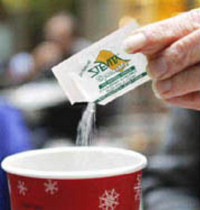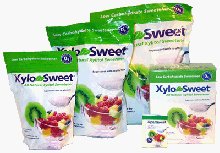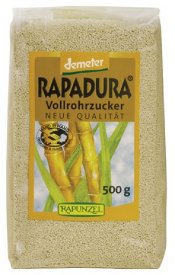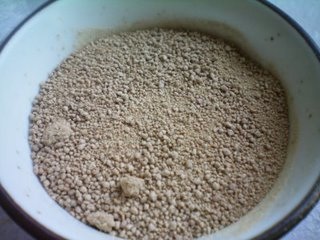| Share |  |
 | |||
Healthy Sweeteners - Part 2
The verse in Proverbs 24:13 (NLT) that says, "My child, eat honey, for it is good, and the honeycomb is sweet to the taste", is just one of many places in the Bible that suggests God intends for us to enjoy a taste of sweetness in our diets. He has provided sweeteners found in nature with many benefits over the refined sugars that are stripped of the majority of their nutrients during the refining process.
Natural sweeteners have many advantages over sugar. They retain their valuable nutrients and do not rob the body of vital enzymes, minerals, and vitamins in order to be digested and assimilated. Many of them contain fewer calories. Many also rate lower than sugar on the glycemic scale, which means that they do not raise blood sugar levels or spike insulin as much as sugar does. Best of all, they are non-toxic, chemical free and far safer than artificial sweeteners.
Many also rate lower than sugar on the glycemic scale, which means that they do not raise blood sugar levels or spike insulin as much as sugar does. Best of all, they are non-toxic, chemical free and far safer than artificial sweeteners.
It is important to keep in mind, however, that even many natural sweeteners can elicit the same harmful spiking of insulin and rising of blood sugar levels as sugar does (see my article on “Sugar Bondage – Why You Need to Be Free” for a better understanding of the importance of controlling blood sugar levels). They can also contribute to the cycle of cravings and addiction, which leads to over consumption of high glycemic foods, which in turn results in weight gain with all of its related health problems.
All sweeteners should be used sparingly, as the focus ought to be on obtaining the sugars that the body needs for energy production from more nutrient-dense foods such as fruits, vegetables and whole grains. But for those occasions when you do want to use a sweetener in a food or beverage, the ones I have featured in this article would be better choices for your health than refined sugar.
Stevia
The sugar alternative I would most recommend is stevia, a natural herb that is not only free of calories and chemicals, but also has the least effect on raising blood sugar or insulin levels. This nutrient-rich herbal plant from the chrysanthemum family is native to South America, and its dried leaves have been safely used as a sweetener in various countries for hundreds of years with no known side effects. It has been especially popular in Japan since the 1970’s and comprises almost half of their commercial sweetener market.  Stevia has been slow to gain popularity in the United States. Though the Food and Drug Administration regarded it as safe to use prior to1980, it was taken off the GRAS (“Generally Regarded as Safe”) list around the time aspartame was becoming popular. It was later banned in 1991, surrounding some controversy, where the FDA stated it was considered an “unsafe food additive,” after receiving an anonymous complaint, when on the other hand, some government officials claimed it was banned for trade restrictions since Stevia occurs naturally, requiring no patent to produce it. Congress passed legislation in 1994, however, that allowed for its use as a dietary supplement, though it was still not approved as a food additive or sweetener. In December of 2008, an extract of stevia known as rebiana, made with a small percentage of sugar alcohols and other ingredients, was given GRAS status by the FDA. This refined version, produced by the Coca Cola and Pepsi Cola companies primarily for use in their soft drinks, goes by the trademark names of Truvia® and PureVia® respectively. Pure Stevia extracts and whole leaf stevia products are generally found in health food stores or online supplement sites because they still can only be sold when labeled as a dietary supplement.
Stevia has been slow to gain popularity in the United States. Though the Food and Drug Administration regarded it as safe to use prior to1980, it was taken off the GRAS (“Generally Regarded as Safe”) list around the time aspartame was becoming popular. It was later banned in 1991, surrounding some controversy, where the FDA stated it was considered an “unsafe food additive,” after receiving an anonymous complaint, when on the other hand, some government officials claimed it was banned for trade restrictions since Stevia occurs naturally, requiring no patent to produce it. Congress passed legislation in 1994, however, that allowed for its use as a dietary supplement, though it was still not approved as a food additive or sweetener. In December of 2008, an extract of stevia known as rebiana, made with a small percentage of sugar alcohols and other ingredients, was given GRAS status by the FDA. This refined version, produced by the Coca Cola and Pepsi Cola companies primarily for use in their soft drinks, goes by the trademark names of Truvia® and PureVia® respectively. Pure Stevia extracts and whole leaf stevia products are generally found in health food stores or online supplement sites because they still can only be sold when labeled as a dietary supplement. 
Stevia has a very sweet taste with a somewhat bitter aftertaste that some regard as similar to licorice. Higher quality stevia products, though, have very little of the bitter taste. The leaves of stevia contain chemical compounds, called glycosides, which account for its incredibly sweet taste. The most common of these glycosides are steviosides, which are generally 200-300 times sweeter than sugar. Other stevia leaf constituents, called rebaudiosides (the main ingredient in rebiana), can be as much as 400 times sweeter than sugar.
Stevia that comes in a white powder extract or clear liquid extract is refined stevia, which is comprised of isolated steviosides generally standardized to 80-90%. This stevia usually tastes better than unrefined green stevia powder made from the dried leaves though it does not contain as many nutrients. Green unrefined stevia is approximately 15 to 30 times sweeter than common table sugar. There is also a liquid form of stevia, made from the whole leaf that is very dark and varies in purity and strength depending upon who makes it. Packets of a “stevia blend” also are available that contain fillers such as malto-dextrin to tone down the strength of the stevia and make it more suitable for tabletop use.  This form is about 10-15 times sweeter than sugar. The taste and degree of sweetness of the various forms of stevia depend on many factors, such as where it was grown and how it was processed. To better adjust to the taste of stevia, it is best to start with using smaller amounts.
This form is about 10-15 times sweeter than sugar. The taste and degree of sweetness of the various forms of stevia depend on many factors, such as where it was grown and how it was processed. To better adjust to the taste of stevia, it is best to start with using smaller amounts.
Stevia can be used in baking as it is heat stable up to 392˚, but there are a few cooking limitations to consider with its use. It cannot be used in recipes with yeast, as sugar is required to feed yeast. It also cannot be used in meringue, as it does not caramelize or brown well. Baked goods will not brown on top as much as they normally would with other sweeteners. For detailed information concerning how to substitute the various types of stevia for other sweeteners in a recipe, I would suggest that you check out these links: http://www.cookingwithstevia.com/stevia_conversion_chart.html or http://www.ehow.com/how_2268348_substitute-stevia-sugar-baking.html
Stevia cookbooks are available for reference, which give many wonderful and healthful recipes. A few I would recommend are:
“Stevia Sweet Recipes: Sugar-Free-Naturally” by Jeffrey Goettlemoeller
“Sensational Stevia Desserts” by Lisa Jobs & Andrew P. Mandell
“Stevia – naturally sweet recipes for desserts, drinks and more!” by Rita DePuydt
Xylitol
 Xylitol is a five-carbon sugar that naturally occurs in birch tree bark, straw, corncobs, and the fiber of fruits and vegetables such as raspberries, plums, corn, and mushrooms. It is also referred to as “wood sugar”, as it is primarily extracted from birch tree pulp (although some manufacturers now use corncobs in an effort to conserve birch forests). It is extracted through the use of steam without the use of chemicals. Xylitol has the same sweetness as sugar, but with 40% less calories, 75% less carbohydrates and a relatively low glycemic index rating of seven (compared to 68 for sugar).
Xylitol is a five-carbon sugar that naturally occurs in birch tree bark, straw, corncobs, and the fiber of fruits and vegetables such as raspberries, plums, corn, and mushrooms. It is also referred to as “wood sugar”, as it is primarily extracted from birch tree pulp (although some manufacturers now use corncobs in an effort to conserve birch forests). It is extracted through the use of steam without the use of chemicals. Xylitol has the same sweetness as sugar, but with 40% less calories, 75% less carbohydrates and a relatively low glycemic index rating of seven (compared to 68 for sugar).
The greatest advantage of Xylitol is that it is safe for diabetics and those with hypoglycemia because it is absorbed slowly in the body and does not depend on insulin for its metabolism (see Sugar Bondage – Pt. 2 for more information on health risks associated with elevated insulin). The effect it has on blood sugar has been shown to even help reduce cravings for carbohydrates.
 Xylitol is unique among sweeteners as it is actually good for teeth because it inhibits bacteria that promote the development of cavities. It helps to clean and protect teeth by reducing plaque formation and increasing salivary flow in the mouth. It is useful as well in preventing gingivitis, gum infections and periodontal disease. Xylitol’s reputation of benefiting oral health makes it a popular sweetener for use in many chewing gums, mouthwashes and toothpastes.
Xylitol is unique among sweeteners as it is actually good for teeth because it inhibits bacteria that promote the development of cavities. It helps to clean and protect teeth by reducing plaque formation and increasing salivary flow in the mouth. It is useful as well in preventing gingivitis, gum infections and periodontal disease. Xylitol’s reputation of benefiting oral health makes it a popular sweetener for use in many chewing gums, mouthwashes and toothpastes.
Xylitol has also been known to stop the growth of yeast and has been used for sinus and ear infections because it is believed to kill certain bacteria and fungus causing these conditions. In a double-blind research study, there was a 40 % reduced risk of ear infections in children who chewed gum sweetened with Xylitol compared to those who chewed gum with other sweeteners. Xylitol also does not feed the yeast that causes Candida as other sugars do. A report published in “Microbial Ecology in Health and Disease (2005)” revealed that consumption of xylitol may even help control oral infections of Candida yeast.
Xylitol is available in a granulated white powder similar to sugar. It is easy to substitute Xylitol for sugar in recipes, as the amounts used are the same (though some say using less still provides a sufficiently sweet product). It can be used in all baking except where yeast is involved. Xylitol dissolves very well in hot drinks, though not as well in cold drinks.
A cookbook I would recommend with recipes using Xylitol is: “Sweeten Your Life the Xylitol Way” (second edition) by Karen Edwards, PhD
Organic Dehydrated Cane Juice
Evaporated or dehydrated cane sugar is an extraction of the whole sugar cane made using rollers to press out the juice of the cane shortly after it is harvested. The juice is then filtered and heat evaporated until it is reduced to a rich, dark syrup, which is cooled and dried by “hand paddling”. This process forms dry, tan-colored granules that can be substituted in equal portions to brown or white sugar in a recipe. Dehydrated cane juice has a rich molasses flavor and retains more of the iron, calcium, potassium, B vitamins and chromium from the sugar cane plant than refined white sugar. However, from a calorie and blood sugar standpoint, it is much like sugar and should be used sparingly. Sucanat, which stands for “SUgar CAne NATural” and Rapadura are the most recommended of the cane juice sugars from a health standpoint, as they are the least processed. There are other similar brownish colored sugars such as turbinado, demerera, Florida crystals, raw sugar, etc. Though these may be an improvement over highly refined white or brown sugar, they are more refined than Sucanat or Rapadura as they undergo additional steps of processing that involve the separation and recombining of the molasses in addition to a crystallization process.
Sucanat, which stands for “SUgar CAne NATural” and Rapadura are the most recommended of the cane juice sugars from a health standpoint, as they are the least processed. There are other similar brownish colored sugars such as turbinado, demerera, Florida crystals, raw sugar, etc. Though these may be an improvement over highly refined white or brown sugar, they are more refined than Sucanat or Rapadura as they undergo additional steps of processing that involve the separation and recombining of the molasses in addition to a crystallization process.
The granules of dehydrated cane juice do not dissolve as readily as crystallized sugar and will remain gritty when mixed with butter in recipes, giving some baked goods a spotty appearance (Rapadura dissolves better as the granules are finer). Despite that disadvantage, Sucanat and Rapadura provide a nice flavor to sweets like cookies, cakes, bars, fruit crisps and cobblers. Though you can use the same amount of dehydrated cane granules as the amount of sugar called for in the recipe, a less sweet product may be made by reducing the cane sugar by a third or a half and using other dry ingredients or date sugar for the remaining portion.
Sucanat and Rapadura are available in health food stores and whole food markets as well as online. Be sure to purchase organic products, as any pesticides and chemicals used on the cane will be concentrated during processing.
Date Sugar & Dried Fruits Date sugar is comprised simply of dates that have been dried and pulverized. As this sugar is not heated or actually processed in any way, it retains its rich store of iron, potassium, various vitamins and other nutrients. It has the further advantage of being high in fiber that slows down absorption of the sugars. One disadvantage of date sugar is that is does not dissolve very well, However, it still can be used in many ways, such as in baking and crumb toppings.
Date sugar is comprised simply of dates that have been dried and pulverized. As this sugar is not heated or actually processed in any way, it retains its rich store of iron, potassium, various vitamins and other nutrients. It has the further advantage of being high in fiber that slows down absorption of the sugars. One disadvantage of date sugar is that is does not dissolve very well, However, it still can be used in many ways, such as in baking and crumb toppings.
Dates are not the only dried fruit that can be used as a sweetener. Raisins, cranberries, apricots, apples and other fruits all can add sweetness to desserts, breads and snacks. They are a good source of fiber as well as nutrients.
Unfortunately, dried fruits do raise blood sugar and are high in calories, since the sugar becomes quite concentrated when all the water is removed. For instance, a cup of grapes has 60 calories but a cup of raisins has 495 calories! So if you have blood sugar or weight issues, it is advisable to consume dried fruits in moderate quantities.
Conclusion
In Part Three of “Healthy Sweeteners”, we will cover liquid natural sweeteners such as Agave, Honey, Maple Syrup, Molasses, Grain syrups and juice concentrates. If you have any questions concerning this article, please post a comment below and we'll be happy to answer them.
Copyright © 2008-2015 Lucinda Bedogne, CNHP, CNC
Reader Comments...
| 2011-01-27 00:26:54 "Hi I am looking for a sugar replacement that will not spike my blood sugar and xylitol seems to be one of the better ones like another reader would like to know which brands are steam processed and not chemically processed. regards," - Linda |
| 2010-12-07 11:27:59 "I am curious about xylitol. I read lots of good things, but some health advisors tell me that the chemical process of xylitol is bad for our health. Your article says that its processed with steam and not chemicals. Do you know what brands do not use chemicals to process the xylitol. I would also like it to come from trees and not GMO corn." - Kelly |
Post Your Comment...
|
|
||||||||||||


